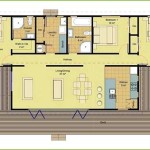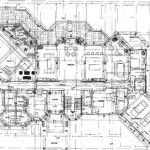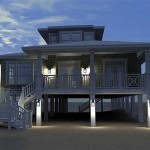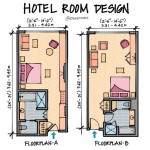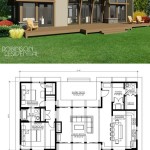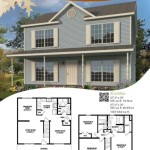Complete House Plan With Dimensions: A Comprehensive Guide
A well-defined house plan with dimensions is fundamental to the successful construction of any residential property. It serves as a blueprint, communicating the design intent from the architect or designer to the builder and other tradespeople involved in the project. The plan ensures accurate construction, minimizes errors, and provides a clear visualization of the final product. This document must contain precise measurements and details to guide the construction process efficiently.
The importance of a complete house plan with dimensions extends beyond the construction phase. It also plays a critical role in obtaining building permits, securing financing, and facilitating future renovations or additions. A comprehensive plan offers a detailed record of the property's layout and structural components, proving invaluable for property owners and future buyers.
Key Components of a Complete House Plan
A comprehensive house plan encompasses several essential components, each contributing to a complete understanding of the building's design and specifications. These components include site plans, floor plans, elevations, sections, and detailed construction drawings.
The site plan illustrates the location of the house on the property, taking into account its relationship to property lines, setbacks, easements, utilities, landscaping, and other site features. Dimensions on the site plan indicate the building's footprint and its distance from property boundaries. This ensures compliance with local zoning regulations and proper integration with the surrounding environment.
The floor plan is a horizontal section showing the layout of rooms and spaces within the house. It includes dimensions for each room, wall thicknesses, door and window locations, and the placement of fixtures such as plumbing and electrical outlets. Floor plans are essential for understanding the flow of the house, the functionality of each space, and the overall dimensions of the building. They also provide a basis for interior design and furniture placement.
Elevations display exterior views of the house from all sides. They depict the vertical dimensions of the building, including roof heights, window and door heights, and the finished grade line. Elevations also show exterior materials and finishes, such as siding, brick, or stone. Accurate dimensions on elevations ensure that the building's appearance matches the design intent and that the exterior is properly constructed.
Sections are vertical cuts through the house, providing a view of the interior structure and construction details. They show the relationship between different levels of the house, including the foundation, walls, floors, and roof. Sections typically include dimensions for wall heights, floor joist depths, and roof pitches. They are particularly important for understanding the structural integrity of the building and ensuring that it complies with building codes.
Detailed construction drawings, also known as details, provide enlarged views of specific building components, such as wall sections, window and door installations, and stair details. These drawings include dimensions, material specifications, and construction notes. Details are essential for ensuring that critical building elements are constructed correctly and that they meet the required performance standards.
Types of Dimensions Used in House Plans
House plans employ various types of dimensions to precisely convey the measurements and spatial relationships within the building. These dimensions can be categorized as overall dimensions, interior dimensions, and component dimensions.
Overall dimensions define the total size of the building. They indicate the length, width, and height of the house, as well as the dimensions of any attached structures, such as garages or porches. Overall dimensions are typically shown on the site plan and floor plans, providing a quick reference for the building's size and footprint.
Interior dimensions specify the size of individual rooms and spaces within the house. They include the length, width, and height of each room, as well as the dimensions of doorways, windows, and other interior features. Interior dimensions are crucial for planning furniture layouts and ensuring that the spaces are functional and comfortable.
Component dimensions provide detailed measurements for specific building elements, such as walls, doors, windows, and stairs. They include the thickness of walls, the size of door and window openings, and the rise and run of stairs. Component dimensions are essential for ensuring that these elements are properly constructed and that they meet the required performance standards. They are typically found on detailed construction drawings and sections.
Dimensions are usually indicated using a specific format consisting of numerical values followed by a unit of measurement (e.g., feet and inches, or meters and millimeters). They are typically placed outside the object being measured, with extension lines indicating the points being dimensioned. Dimension lines connect the extension lines and indicate the length of the dimension. Arrowheads or slashes are used to terminate the dimension lines. Consistent and clear dimensioning practices are essential for avoiding confusion and ensuring accurate construction.
Importance of Accuracy and Clarity in Dimensions
The accuracy and clarity of dimensions in a house plan are paramount for the successful execution of the project. Inaccurate or ambiguous dimensions can lead to costly errors, delays, and even structural problems. Therefore, it is crucial to ensure that all dimensions are carefully verified and clearly presented.
Inaccurate dimensions can result in mismatches between building components, such as walls, doors, and windows. This can require costly rework and delays in the construction schedule. For example, if a wall is dimensioned incorrectly, it may be too short or too long, requiring the builder to adjust the framing or order custom-sized materials.
Ambiguous dimensions, such as those that are unclear or conflicting, can also lead to errors and misunderstandings. For example, if a dimension is not clearly labeled or if it conflicts with another dimension on the plan, the builder may misinterpret the intended measurement. This can result in incorrect construction and require corrective action.
To ensure accuracy and clarity, it is essential to use consistent dimensioning practices, double-check all dimensions, and clearly label each dimension. It is also helpful to use a scale ruler or computer-aided design (CAD) software to verify the accuracy of the dimensions. Regular communication between the architect or designer and the builder is crucial to address any questions or concerns regarding the dimensions.
Moreover, compliance with industry standards and local building codes is critical. Most jurisdictions have specific requirements for the format and content of house plans, including dimensioning practices. Adhering to these requirements ensures that the plans are readily understood and approved by building officials.
For example, many jurisdictions require that all dimensions be shown in metric units or imperial units and that the plans include a scale bar for easy reference. They may also require that certain dimensions, such as those relating to fire safety or accessibility, be highlighted for emphasis. Failure to comply with these requirements can result in delays in obtaining building permits and may require revisions to the plans.
In addition to regulatory requirements, it is also important to consider the practical needs of the builder and other tradespeople who will be using the plans. The plans should be easy to read and understand, with clear and concise dimensions that are readily accessible. It is also helpful to provide supplementary information, such as material specifications and construction notes, to clarify the design intent.
Ultimately, a complete house plan with accurate and clear dimensions is the foundation for a successful construction project. It facilitates communication, minimizes errors, and ensures that the building is constructed according to the design intent. Investing in a comprehensive and well-prepared plan is a wise investment that can save time, money, and headaches in the long run.
Common Mistakes in House Plan Dimensions
While the goal is to achieve perfection in house plan dimensions, certain common mistakes can arise, leading to construction errors. Recognizing and avoiding these pitfalls is critical for ensuring a smooth building process.
One frequent error involves omitting dimensions. Leaving out crucial measurements forces builders to make assumptions, which can lead to inaccuracies. This is especially problematic in complex areas of the design, where precise measurements are essential. Every element of the house, from walls to windows to doors, should have its dimensions clearly indicated on the plans.
Another common mistake is the presence of conflicting dimensions. This occurs when two or more dimensions on the plan contradict each other, creating ambiguity and uncertainty. Such conflicts can arise from errors in calculation or drafting or from revisions that were not properly coordinated across the entire set of plans. Resolving these conflicts requires careful review and correction of the dimensions to ensure consistency.
Incorrect unit usage also poses a significant risk. Mixing metric and imperial units, or using the wrong unit for a particular measurement, can lead to substantial errors in construction. For example, specifying a wall thickness in inches when the intended unit was millimeters would result in a drastically different dimension, potentially compromising the structural integrity of the building. Adhering to a consistent unit system and clearly indicating the units used for each dimension is essential.
Failure to account for wall thicknesses represents another potential source of error. Dimensions should explicitly distinguish between inside dimensions (clear space within a room) and outside dimensions (overall size of the building). Neglecting to account for wall thicknesses when calculating room sizes can lead to discrepancies between the planned layout and the actual constructed space. Clear labeling of inside and outside dimensions, along with accurate indication of wall thicknesses, is crucial for preventing this error.
Finally, lack of dimensioning for key features, such as staircases or bathrooms, can create difficulties during construction. Staircases require precise dimensions to ensure safety and compliance with building codes. Bathrooms involve complex plumbing and fixture layouts that demand accurate measurements. Failure to provide adequate dimensions for these key features can result in costly rework and delays. Comprehensive dimensioning of all critical elements is essential for a successful project.

Architecture House Plan And Elevation Complete Drawing Bungalow Floor Plans Building Designs

Adjusting Modularity Of The 5 Bedroom Complete House To Conform With Scientific Diagram

Floor Plan With Dimensions 1 One House Plans Bungalow Cottage

About Frank Betz Associates Stock Custom Home Plans

Floor Plan Complete Seq Building Design

Complete Cottage House Plans And Construction Drawings

Complete Floor Plan For Your Dream Home Using Autocad Upwork

Mediterranean House Plan Tuscan Inspired Golf Course Home Floor

Traditional Two Y House Plan Complete With Elevations Engineering Discoveries

What S Included In House Plans
Related Posts

